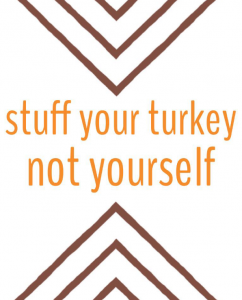LisaTheRD’s Survival Guide for the Thanksgiving Holiday
Part 2: Table Matters
 In my last blog entry, we discussed preparing good strategies for Thanksgiving dinner, that annual event wherein many people stuff themselves with the vigor of an indulgent parent hurriedly cramming full an oversized pinata for a kid’s birthday party.
In my last blog entry, we discussed preparing good strategies for Thanksgiving dinner, that annual event wherein many people stuff themselves with the vigor of an indulgent parent hurriedly cramming full an oversized pinata for a kid’s birthday party.
In this blog entry, we’re ready to take on “T-Day” itself; the big event.
When you take a seat at the table, select a chair as comfortable as possible. Sit where you have a nice view, and choose a spot that puts you with pleasant and positive people as dining companions. (Don’t, for instance, sit next to Aunt Agatha who always nags you about getting married, or next to Uncle Eddie who will angrily rant about politics all meal long. And if your dining companions consist solely of nagging, ranting relatives, consider finding a place at the kids’ table.)
As you prepare to eat, take a moment to become fully present. Use all your senses; be aware of the smells, sights, noises around you. Bring this same way of being aware to the food as you start to eat. This kind of grounded presence will make the food more enjoyable and you will automatically eat slower.
At this time, you might also think about at least three goals you’re hoping to achieve during the meal. These goals can be about your food intake, (i.e. drink three glasses of water, finish when no longer hungry, etc.) or about connecting with others around you (i.e. have a meaningful conversation with Cousin Hank, get to know a new face at the table, etc.)
Another strategy to avoid stuffing yourself is to come up with a way to track how your body responds to what you are eating. You might evaluate your level of hunger on a scale of one to ten and plan to stop when you reach seven. Another similar approach is to imagine a “Hunger Highway Traffic Light” (green means hungry, yellow means not quite so hungry, and red means hunger is satisfied.) You might plan to slow down at yellow, and stop at red.
If possible, see if you can get a fellow diner to be your “eating buddy” and the two of you can encourage each other’s consumption goals. During the meal each of you can remind the other to check in and assess hunger numbers and fullness levels. You can also share support through mutual coaching to insure that both of you eat your meal slowly, taking time to enjoy your dinner.
And speaking of which…
DINNER IS SERVED!
Of course, the rubber meets the road when the food meets the plate. If possible, your plate should be on the small side. A recent study suggests that people will eat more when food is offered on a larger plate. But no matter what size your plate is, don’t pile food onto it. Realize that a mouthful of something yummy is just as satisfying as a massive mound of it.
Here’s a helpful strategy I recommend to my clients: Divide your plate into quarters, with each quarter dedicated to a type of the range of foods offered. One quarter of the plate should be set aside for your protein, while another quarter is dedicated to the assortment of small serving samples of all the carbs that catch your fancy, and two quarters for the various veggie dishes. Sauces and dressing as best taken in small amounts on the side, and then drizzled on sparingly. You’ll find that a plate offering tastes of lots of different foods will be thoroughly satisfying—after all, the first taste is the most satisfying—and far less filling.
If you really can’t resist taking a second helping, my recommendation is that you reserve that plate for one-third protein, two-thirds veggies. Your dessert plate should be as small as possible, consisting of fruit apportioned on one half, and small tasting samples of the other treats making up the other half.
As a final strategy, think of something with which to reward yourself—a non-food reward, naturally!—if you are able to leave the table comfortably satisfied and not over-full. Decide what this reward will be (ok, feel free to considerate it a self-bribe) before the meal begins. That way you can have something to look forward to, in addition to the good feeling you’ll achieve as you acknowledge how well you demonstrated your own commitment to yourself.
A FINAL THOUGHT
Finally, if we and those we love are able to walk away from the Thanksgiving meal without stuffing ourselves, we are also setting the stage for another Thanksgiving seasonal tradition: more leftovers!





